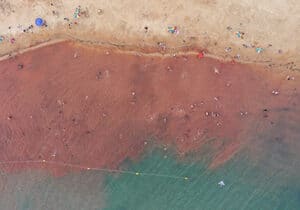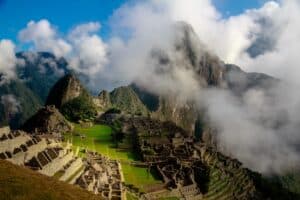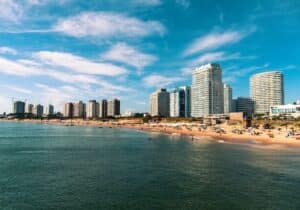South America is a continent of breathtaking landscapes, vibrant cultures, and welcoming locals, but safety can vary widely between countries.
The safest South American countries, with Uruguay and Chile leading the pack, combine low crime rates, stable political environments, and effective law enforcement. As a traveler or expat, you can enjoy exploring major cities, pristine beaches, or the Sacred Valley by staying informed, respecting local laws, and exercising normal precautions.
Here’s a look at the safest South American countries to visit or relocate to in 2025:
How We Ranked the Safest South American Countries
When determining the safest countries in South America, we analyzed a combination of international safety data, local crime statistics, and travel advisories to give a balanced, up-to-date picture of each South American country’s safety conditions. Our assessment considered:
- Global Peace Index (GPI) ranking: Measures levels of peace, political stability, and societal safety.
- Crime rates: Focused on both violent crime and petty crime in major cities and tourist hotspots.
- Political stability: Evaluated civil unrest risks, government reliability, and rule of law.
- Infrastructure and public services: Assessed transport safety, road conditions, and access to healthcare.
- Expat communities: Locations with established foreign residents often boast enhanced safety measures and tend to have better access to services.
We also factored in travel advisories from official government sources, local knowledge from residents and expats, and considerations for solo travelers, digital nomads, and families.
While certain Latin American countries face challenges such as political instability, high homicide rates, or dangerous cities, others stand out for their welcoming locals, low crime rates, and effective law enforcement, making them ideal safe destinations to visit or settle in.
6 Safest Countries in South America Ranked from Most to Least Safe
1. Uruguay: The Safest Country in South America
Quick safety stats
- Global Peace Index 2023: 50th globally, 1st in South America.
- Homicide rate: Around 8 per 100,000 (low for the region).
- Political stability: High. Minimal social unrest and strong democratic institutions.
- Key safe cities: Montevideo, Punta del Este, Colonia del Sacramento.
According to the Global Citizen Solutions’ Global Intelligence Unit, Uruguay is widely regarded as the safest South American country. Its stable political environment, strong rule of law, and effective law enforcement contribute to low violent crime rates. Petty crime such as pickpocketing can occur in crowded urban areas, but it is generally safe for tourists, expats, and families.
Uruguay’s welcoming locals, mild climate, and residency by investment options make it attractive for long-term living. Montevideo offers a high standard of living and reliable public services, while Colonia del Sacramento provides a quieter, colonial charm. The country’s consistent rankings in both the Global Peace Index and Quality of Life measures align with its reputation as a safe, peaceful, and politically stable destination.
2. Chile: Stable and Low-Crime in Tourist Areas
Quick safety stats
- Global Peace Index 2023: 58th globally.
- Homicide rate: Around 4.4 per 100,000 (one of the lowest in Latin America).
- Political stability: Moderate, but largely peaceful outside of protest events.
- Key safe areas: Santiago’s central districts, Valparaíso, Atacama Desert, Easter Island.
Chile is one of the safest countries in South America for both travelers and expats, thanks to its low crime rate in tourist areas and strong infrastructure. Its diverse landscapes—from the Atacama Desert to Patagonia—are accessible and well-served by transport and healthcare systems.
While occasional political demonstrations can occur in major urban centers, these are typically concentrated in specific areas and can be avoided by staying informed via local news. Chile’s tourist hotspots benefit from a visible police presence, and the country’s mild climate and vibrant cities make it an appealing long-term base for digital nomads and retirees.
3. Argentina: Safe in Most Urban and Tourist Areas

- Global Peace Index 2023: 54th globally.
- Homicide rate: Around 5 per 100,000.
- Political stability: Moderate.
- Key safe cities: Buenos Aires (central areas), Mendoza, Bariloche.
Argentina offers a mix of vibrant cities, rich culture, and natural wonders like Iguazu Falls and Patagonia. While petty theft can occur in large cities, violent crime rates are relatively low compared to other Latin American countries. Buenos Aires, Mendoza, and Bariloche are among the safest cities in South America for tourists.
Tourist police units are active in key areas, and Argentina’s friendly locals and high standard of living attract both short-term visitors and long-term expats. Economic instability can lead to occasional protests, but these are rarely dangerous for visitors who avoid affected areas.
4. Paraguay: Under-the-Radar Safety for Expats and Travelers

- Global Peace Index 2023: 71st globally.
- Homicide rate: Around 8.7 per 100,000.
- Political stability: Generally stable with low levels of civil unrest.
- Key safe areas: Asunción, Encarnación.
Paraguay may not be the first destination that comes to mind for travelers, but it consistently ranks among the safer South American countries. The capital city, Asunción, has a relaxed pace of life and relatively low crime rates compared to the region’s larger urban areas. Petty crime can occur in crowded markets, but violent crime rates remain low.
The country’s welcoming locals, low cost of living, and stable political environment make it increasingly popular among retirees and digital nomads seeking a peaceful, affordable base in Latin America.
5. Ecuador: Safe Tourist Hubs with Some Caution in Cities
Quick safety stats
- Global Peace Index 2023: 97th globally.
- Homicide rate: Around 14 per 100,000 (lower in tourist regions).
- Political stability: Moderate. Some protests have occurred in recent years.
- Key safe areas: Galápagos Islands, Cuenca, Quito’s historic center.
Ecuador offers some of the safest travel destinations in South America for tourists—particularly the Galápagos Islands and the colonial city of Cuenca. These areas benefit from strong police presence, low crime rates, and a focus on sustainable tourism.
While Guayaquil and certain neighborhoods of Quito experience higher crime rates, most popular destinations are safe when normal precautions are taken. Ecuador’s rich culture, biodiversity, and well-developed tourist infrastructure make it appealing for families, adventure travelers, and expats.
6. Peru: Popular and Generally Safe in Tourist Regions

- Global Peace Index 2023: 103rd globally.
- Homicide rate: Around 7.6 per 100,000.
- Political stability: Moderate. Occasional protests happen, especially in Lima and Cusco.
- Key safe areas: Sacred Valley, Machu Picchu, Arequipa.
Peru is one of South America’s most visited countries, with world-famous destinations like the iconic Machu Picchu, Sacred Valley, and Lake Titicaca. Most tourist areas are considered safe, especially when visited with guided tours.
While the country experiences periodic political protests, these rarely affect tourist travel if you stay informed and avoid affected areas. Petty theft can be an issue in crowded urban centers, but violent crime is relatively uncommon in the main tourist corridors.
South American Countries to Exercise Caution In
While many South American nations offer safe destinations, some countries or regions require increased caution due to higher crime rates, political instability, or civil unrest.
This doesn’t mean they should be avoided entirely as many still have beautiful, safe places to visit but travelers should be well-informed, follow local laws, and take extra safety measures.
Brazil
Brazil is known for its vibrant culture, beautiful beaches, and cities like Rio de Janeiro and São Paulo. However, it has higher crime rates in certain urban neighborhoods.
Tourist-friendly areas such as Florianópolis and Curitiba are generally safer, with lower homicide rates and a stronger police presence.
Colombia
Colombia has made significant safety improvements over the past decade, with cities like Cartagena and parts of Medellín attracting more tourists and digital nomads. Still, certain rural regions and urban districts have higher crime rates.
Venezuela
Currently considered the least safe country in South America due to high violent crime rates and political unrest. Shortages of goods and frequent power outages can also affect travelers.
Guyana
Guyana is rich in natural beauty, including the Amazon rainforest, but has higher petty crime and some violent crime in urban areas like Georgetown. Infrastructure can also be limited outside metropolises.
Suriname
While relatively peaceful compared to some neighbors (French Guiana and Guyana), Suriname has occasional petty theft and opportunistic crime in urban areas. Rural and jungle regions can pose logistical and safety challenges.
Travel Safety Tips and Best Practices for South America
Whether you’re visiting for a short trip or planning a long-term stay, following basic safety measures can enhance your experience in even the safest South American countries. From bustling urban areas to remote natural wonders, a few precautions can go a long way toward ensuring a safe and enjoyable journey.
1. Stay informed
Check travel advisories and local news before and during your trip to stay updated on political stability, civil unrest, or natural disasters. In some Latin American countries, protests may sometimes disrupt transportation or prohibit access to certain areas.
2. Use secure transportation
In major cities, opt for official taxis or reputable ride-hailing apps rather than unlicensed street cabs. This is especially important at night or in unfamiliar neighborhoods.
3. Protect your belongings
Petty theft and pickpocketing can occur in crowded areas like markets, public transportation, or popular tourist hotspots. Use anti-theft bags, keep valuables out of sight, and avoid carrying large amounts of cash.
4. Avoid high-risk areas
Research specific destinations in advance. Even in otherwise safe countries, certain neighborhoods or rural regions may have security risks in the form of higher crime rates or limited access to emergency services.
5. Respect local laws and customs
Understanding local laws, cultural etiquette, and safety conditions will help you avoid misunderstandings and integrate more easily into local communities.
6. Consider travel insurance
A comprehensive travel insurance policy can cover medical emergencies, theft, and trip disruption, providing extra peace of mind, especially for longer stays or adventure travel.
7. Solo and digital nomad considerations
Solo travelers should stick to well-lit, busy areas after dark and share itineraries with friends or family.
Those on a digital nomad visa should look for destinations with reliable internet, co-working spaces, and established expat communities, which often indicate better safety and amenities.
Frequently Asked Questions
What is the safest country in South America?
Uruguay is consistently ranked the safest country in South America, with low crime rates, political stability, and high quality of life.
Which South American countries have the lowest crime rates?
Uruguay, Chile, and Argentina have some of the lowest crime rates in the region, especially in their main tourist hubs.
Are there safe cities in South America for solo travelers?
Yes, cities like Montevideo, Santiago, Mendoza, and Cuenca are popular with solo travelers due to their safety, walkability, and friendly locals.
Which South American countries are safest for digital nomads?
Uruguay, Chile, and Argentina offer reliable internet, strong expat communities, and safe urban environments ideal for remote work.
Is South America safe for families?
Several South American countries, including Uruguay and Chile, provide family-friendly neighborhoods, quality education, and low crime rates.
How do Global Peace Index rankings reflect safety in South America?
The Global Peace Index scores countries based on crime rates, political stability, and societal safety. Uruguay and Chile rank highest in the region.
Are there dangerous areas to avoid in South America?
Certain neighborhoods in major cities like Rio de Janeiro, São Paulo, and Caracas have higher crime rates and are best avoided by travelers.
What precautions should tourists take in South America?
Aside from exercising normal precautions when it comes to staying safe, use official taxis or ride-hailing apps, avoid displaying valuables, and stay updated on local news to avoid areas of unrest.
Do political protests affect safety in South America?
Protests can disrupt transportation and occasionally lead to unrest. Avoid large gatherings and monitor local advisories.
Is travel insurance recommended for visiting South America?
Yes, it is. Travel insurance can cover medical care, theft, and trip interruptions, adding extra protection while exploring the region.
Which South American countries are safest for long-term living?
Uruguay, Chile, and Paraguay are popular with expats for their safety, economic stability and established foreign communities.
Are there health risks when traveling in South America?
Most tourist destinations are low-risk, but it’s advisable to check vaccination requirements and be cautious about food and water safety.





